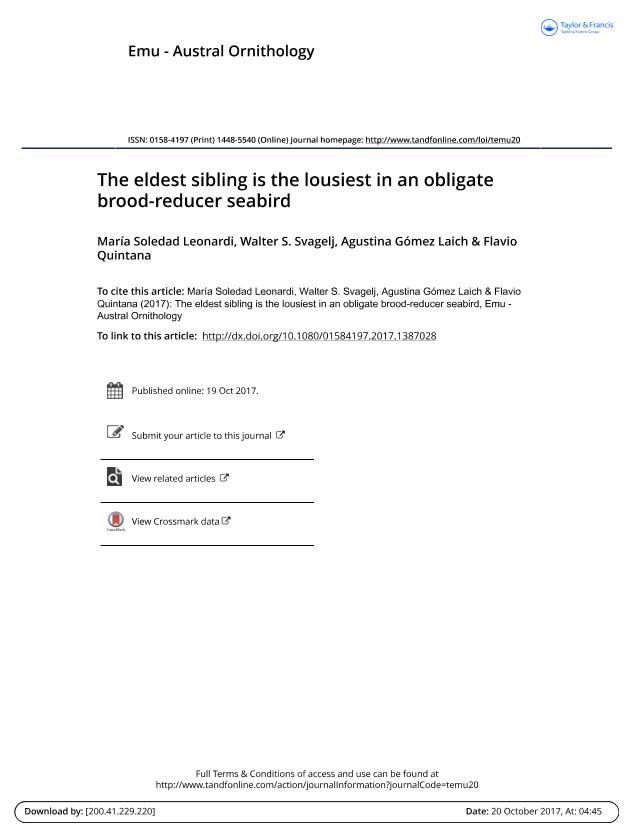Artículo
The eldest sibling is the lousiest in an obligate brood reducer seabird
Leonardi, María Soledad ; Svagelj, Walter Sergio
; Svagelj, Walter Sergio ; Gómez Laich, Agustina Marta
; Gómez Laich, Agustina Marta ; Quintana, Flavio Roberto
; Quintana, Flavio Roberto
 ; Svagelj, Walter Sergio
; Svagelj, Walter Sergio ; Gómez Laich, Agustina Marta
; Gómez Laich, Agustina Marta ; Quintana, Flavio Roberto
; Quintana, Flavio Roberto
Fecha de publicación:
10/2017
Editorial:
Csiro Publishing
Revista:
Emu
ISSN:
0158-4197
e-ISSN:
1448-5540
Idioma:
Inglés
Tipo de recurso:
Artículo publicado
Clasificación temática:
Resumen
Previous studies on vertical transmission of lice on terrestrial birds have shown that the intensity of parasitism can vary within broods in relation to the hatching order of chicks. In species where the hatching order has an important effect on chick survival, lice would benefit from living on the host with the highest survival prospects. In the present work, we test this hypothesis using as model lice from the Imperial Shag, an obligate brood reducer. Our specific aims were to investigate how infestation of Eidmanniella pellucida varies in relation to the age, the order of birth and the hatching date of chicks. We observed that chicks were infested by their parents during their first days of life, mainly by lice in nymphal stage. The first chick to hatch was the most infested. Infestation was also affected by hatching date, increasing as the season progressed, reaching a maximum at the peak of the breeding season and decreasing gradually after that. The age of the chick was unrelated to the intensity of infestation. Our results suggest that lice would prefer the chick that is more likely to survive and highlights the adaptive strategies of lice according to the ecology of their hosts.
Palabras clave:
Chewing Lice
,
Host-Parasite Dynamic
,
Seabirds
,
Shag
,
Transmission
Archivos asociados
Licencia
Identificadores
Colecciones
Articulos(IBIOMAR)
Articulos de INSTITUTO DE BIOLOGIA DE ORGANISMOS MARINOS
Articulos de INSTITUTO DE BIOLOGIA DE ORGANISMOS MARINOS
Citación
Leonardi, María Soledad; Svagelj, Walter Sergio; Gómez Laich, Agustina Marta; Quintana, Flavio Roberto; The eldest sibling is the lousiest in an obligate brood reducer seabird; Csiro Publishing; Emu; 10-2017; 1-6
Compartir
Altmétricas



